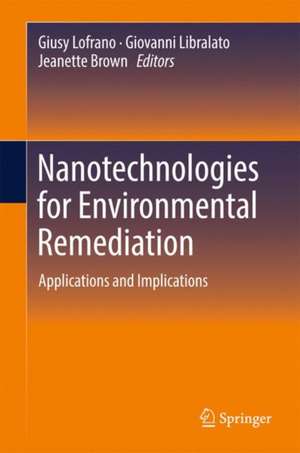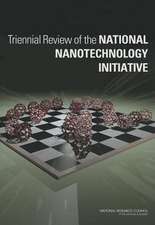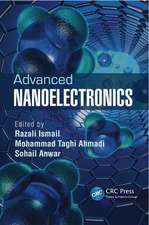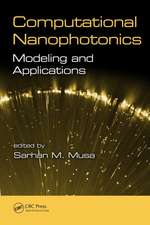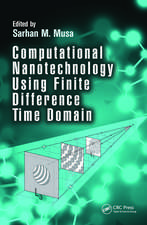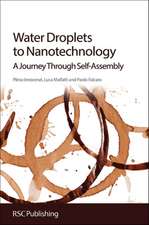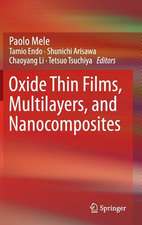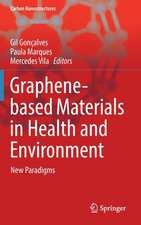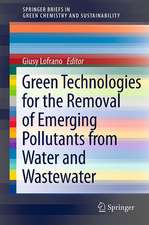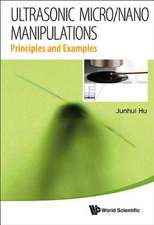Nanotechnologies for Environmental Remediation: Applications and Implications
Editat de Giusy Lofrano, Giovanni Libralato, Jeanette Brownen Limba Engleză Hardback – 10 mar 2017
This timely, multi-author contributed volume is aimed at students, technicians, and academics interested in the role, risks and benefits of nanotechnology in modern environmental contexts.
| Toate formatele și edițiile | Preț | Express |
|---|---|---|
| Paperback (1) | 610.79 lei 38-44 zile | |
| Springer International Publishing – 21 iul 2018 | 610.79 lei 38-44 zile | |
| Hardback (1) | 1008.12 lei 3-5 săpt. | |
| Springer International Publishing – 10 mar 2017 | 1008.12 lei 3-5 săpt. |
Preț: 1008.12 lei
Preț vechi: 1229.41 lei
-18% Nou
Puncte Express: 1512
Preț estimativ în valută:
192.93€ • 200.68$ • 159.27£
192.93€ • 200.68$ • 159.27£
Carte disponibilă
Livrare economică 24 martie-07 aprilie
Preluare comenzi: 021 569.72.76
Specificații
ISBN-13: 9783319531618
ISBN-10: 3319531611
Pagini: 413
Ilustrații: X, 325 p. 75 illus., 58 illus. in color.
Dimensiuni: 155 x 235 mm
Greutate: 0.68 kg
Ediția:1st ed. 2017
Editura: Springer International Publishing
Colecția Springer
Locul publicării:Cham, Switzerland
ISBN-10: 3319531611
Pagini: 413
Ilustrații: X, 325 p. 75 illus., 58 illus. in color.
Dimensiuni: 155 x 235 mm
Greutate: 0.68 kg
Ediția:1st ed. 2017
Editura: Springer International Publishing
Colecția Springer
Locul publicării:Cham, Switzerland
Cuprins
Progress in Nanomaterials Applications for Water Purification.- Nanomaterial for Water Remediation: Synthesis, Application and Environmental Fate.- The Use of Al and Fe Nanoparticles for the Treatment of Micropollutants.- Environmental Nanoremediation and Electron Microscopies.- Adsorption and Desorption Properties of Carbon Nanomaterials, the Potential for Water Treatments and Associated Risks.
Notă biografică
Dr. Giusy Lofrano received her PhD in Environmental Engineering in 2007. She is currently an adjunct professor of environmental impact assessment at the Department of Chemistry and Biology at Salerno University. She has over 10 years of postgraduate experience in environmental protection and restoration technology. Her research interests include advanced oxidation process applications on high strength wastewaters, chemical and biological wastewater treatment, adsorption, industrial pollution control, marine sediments and soil remediation, ecotoxicology and environmental toxicology, engineered nanomaterials, traditional and nano-based technologies, environmental monitoring.
She has been involved as an investigator in many international and national projects. She is a member of the editorial board of several international journals and is the editor of two books on green technologies for wastewater treatment. She has acted as peer-reviser and panelist in the evaluation of manyresearch and technology development projects (EU and national) and papers.
Jeanette Brown is a research assistant professor at the Department of Civil and Environmental Engineering at Manhattan College, Bronx, NY (USA). Her areas of expertise include biological nutrient removal, biosolids management, and energy recovery from wastewater using processes such as anaerobic digestion and gasification. She is a past president of the Water Environment Federation, American Academy of Environmental Engineers and Environmental & Water Resources Institute (EWRI)/American Society of Civil Engineers (ASCE) and was selected as the prestigious Kappa Lecturer by the American Academy of Environmental Engineers and Scientists (AAEES) in 2008. She has published and presented numerous papers at various conferences in the United States as well as internationally. She has also been a contributing author on several books relating to design and operation of wastewater treatment facilities, as wellas resource and energy recovery from wastewater.
Dr. Giovanni Libralato earned his B.S., M.S. and PhD degrees in Environmental Sciences from the Ca’ Foscari University of Venice, Italy. He is an assistant professor at the Department of Biology, University of Naples Federico II, Naples, Italy. His research interests within hygiene include aquatic ecotoxicology, nanoecotoxicology, toxicant effects on populations, factors modifying toxicity, inorganic water chemistry, wastewater treatment, soil remediation, recovery and reuse of by-products, and water reuse.
She has been involved as an investigator in many international and national projects. She is a member of the editorial board of several international journals and is the editor of two books on green technologies for wastewater treatment. She has acted as peer-reviser and panelist in the evaluation of manyresearch and technology development projects (EU and national) and papers.
Jeanette Brown is a research assistant professor at the Department of Civil and Environmental Engineering at Manhattan College, Bronx, NY (USA). Her areas of expertise include biological nutrient removal, biosolids management, and energy recovery from wastewater using processes such as anaerobic digestion and gasification. She is a past president of the Water Environment Federation, American Academy of Environmental Engineers and Environmental & Water Resources Institute (EWRI)/American Society of Civil Engineers (ASCE) and was selected as the prestigious Kappa Lecturer by the American Academy of Environmental Engineers and Scientists (AAEES) in 2008. She has published and presented numerous papers at various conferences in the United States as well as internationally. She has also been a contributing author on several books relating to design and operation of wastewater treatment facilities, as wellas resource and energy recovery from wastewater.
Dr. Giovanni Libralato earned his B.S., M.S. and PhD degrees in Environmental Sciences from the Ca’ Foscari University of Venice, Italy. He is an assistant professor at the Department of Biology, University of Naples Federico II, Naples, Italy. His research interests within hygiene include aquatic ecotoxicology, nanoecotoxicology, toxicant effects on populations, factors modifying toxicity, inorganic water chemistry, wastewater treatment, soil remediation, recovery and reuse of by-products, and water reuse.
Textul de pe ultima copertă
In this book discussing the principles of green chemistry and green engineering an international team of investigators present significant recent developments in applying nanoscience, nanoengineering, and nanotechnology to the area of environmental remediation. The opening chapters introduce candidate nanomaterials, properties, mechanisms that enable the applications, the advantages and limitations compared to existing processes and commercial research requirements. It then explores the detection and application of nanomaterials in photocatalytic processes and as adsorbents, and also covers the effect of nanoparticles in the activated sludge process. Later chapters focus on the effects of nanoparticles on crops, the risks associated with the presence of nanoparticles in the environment, and lastly the environmental effects of nanoscale zero-valent iron (nZVI) on land remediation.
This timely, multi-author contributed volume is aimed at students, technicians, and academics interested in the role, risks and benefits of nanotechnology in modern environmental contexts.
This timely, multi-author contributed volume is aimed at students, technicians, and academics interested in the role, risks and benefits of nanotechnology in modern environmental contexts.
Caracteristici
Includes a review of recent literature on nanoremediation studies Edited by a recognized team of experts Discusses green chemistry and green engineering principles Includes supplementary material: sn.pub/extras
